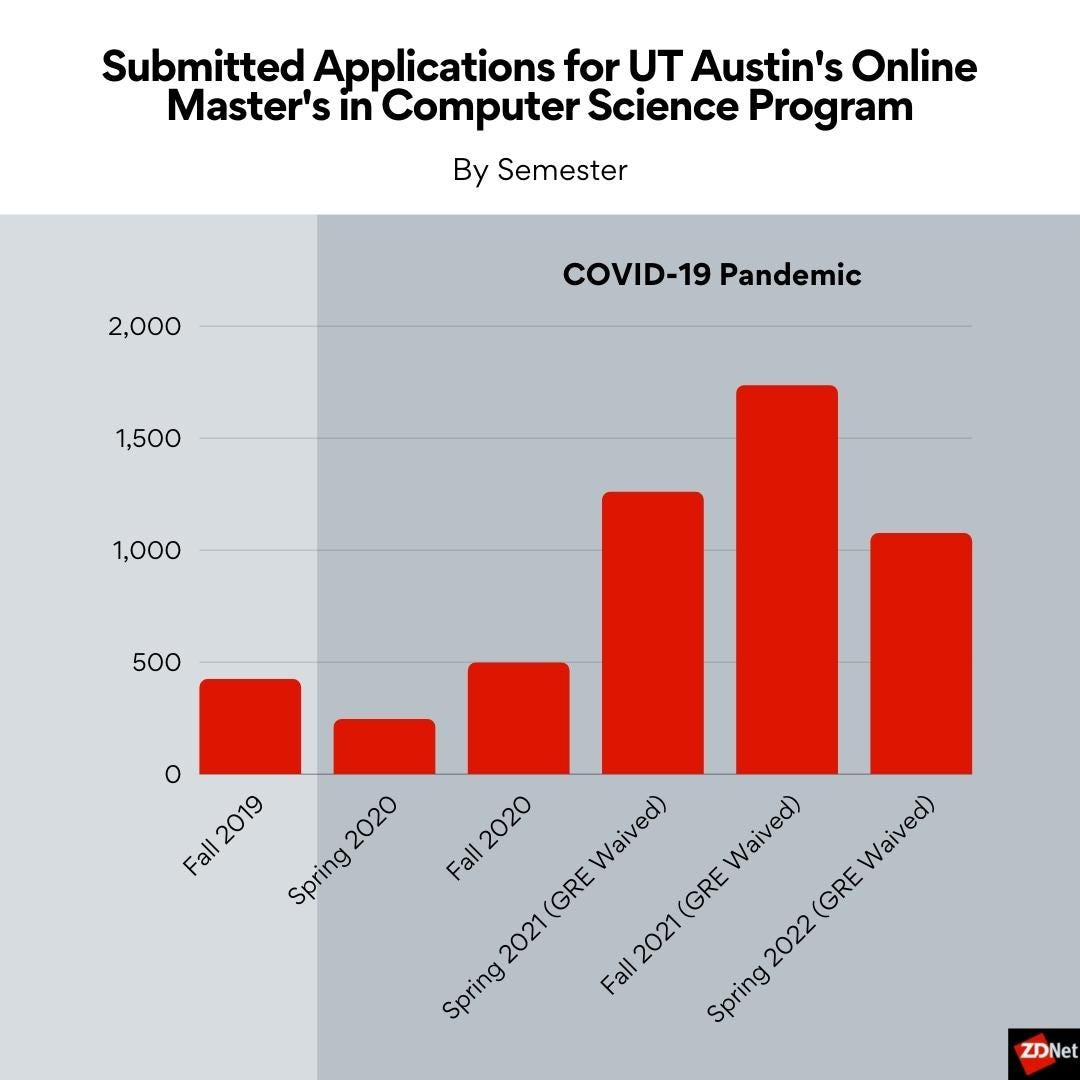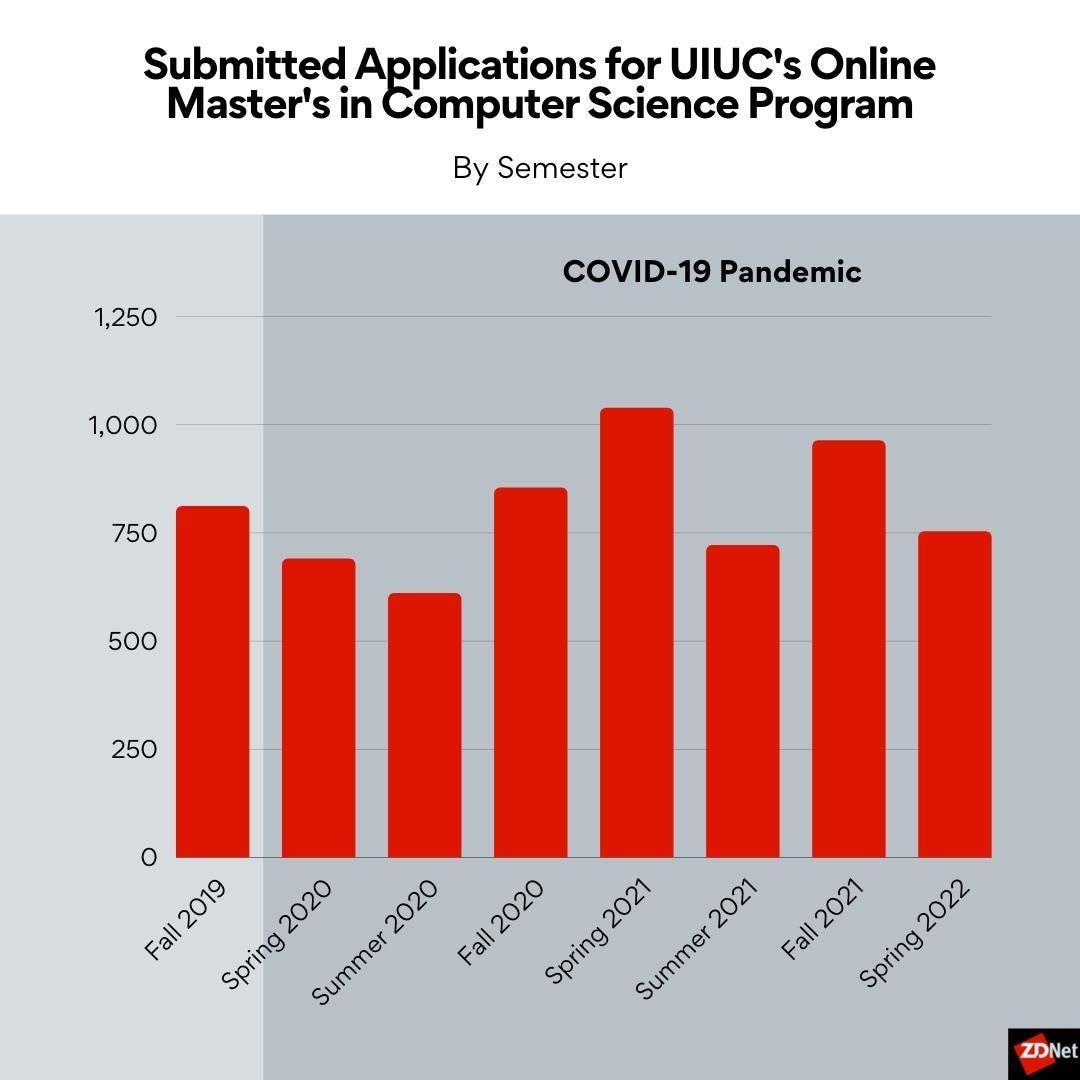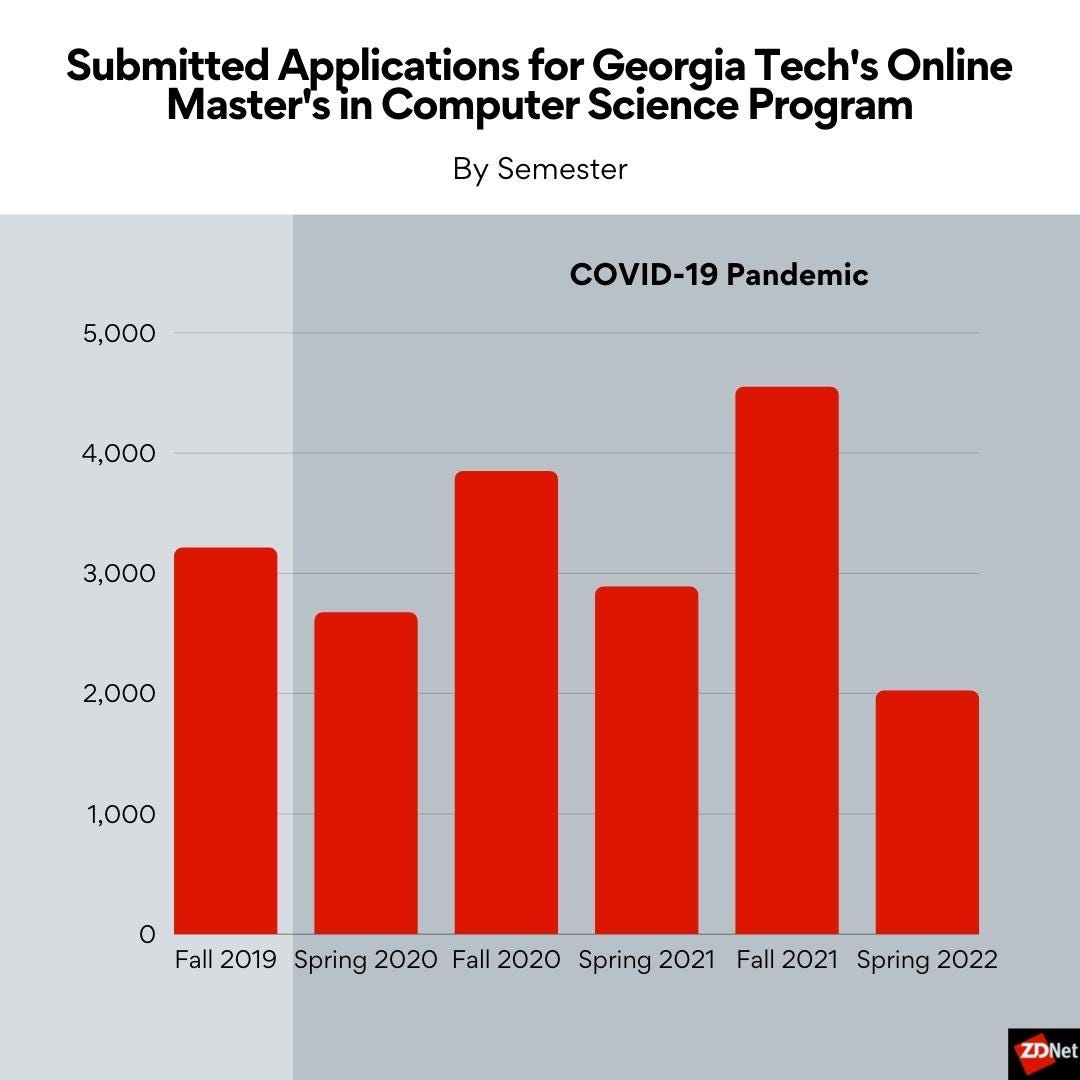-
Enrollment in post-grad computer science programs increased when the pandemic hit.
-
Faced with career and personal upheaval, many people chose to pursue upskilling opportunities through higher education in this popular career field, which has a positive long-term outlook.
-
But enrollment appears to be slowing as the pandemic enters its third year.
A strong, stable career outlook and good earning potential make computer science degrees a popular choice. When the pandemic hit, followed by the Great Resignation, interest in computer science spiked. Many wanted to upskill or pursue a career switch.
In response, colleges and universities touted their online learning options. They expanded existing programs and, in some cases, created new options to earn an advanced degree.
Some schools chose to waive standardized test requirements, opening doors for people who might have otherwise decided not to continue their education.
Online graduate CS programs are a “compelling new option”
Enrollment in online computer science master’s programs surged around the same time as the pandemic. However, educators at three universities ZDNet spoke with stopped short of drawing a direct line between the enrollment uptick and the pandemic.
Eric Busch, Ph.D., is the director for online programs in computer science and data science at the University of Texas at Austin. Busch said it’s difficult to pinpoint the pandemic’s exact effects on the school’s master’s in computer science online (MCSO) program.
“However, the program’s application numbers over the past several semesters show a spike in interest among prospective applicants roughly convergent with the pandemic,” Busch said.
UT Austin admits students on a semesterly rather than a yearly basis. In response to the pandemic’s unprecedented negative effects on daily life, work, and education, UT Austin temporarily waived its GRE requirement for all graduate admissions for the fall semester of 2020. The waiver will continue through the fall 2022 application cycle.
The GRE, or Graduate Record Exam, is a standardized test. Students usually take the GRE and submit their scores as part of the grad school application process.
“That change coincided with the admissions period for the spring of 2021, during which submitted applications to the MCSO program rose by 250% over the previous admissions cycle,” Busch said. “Total applications then rose again by 72% in the following semester. This spike in applications coincided with the most acutely restrictive phase of the pandemic.”
UT Austin’s MCSO program launched in 2019. A similar program in data science started in 2021. Busch called them both “a compelling new option” for students.
The program became available at a time when “many graduate programs were struggling to adapt their existing curricula to online and hybrid formats,” he added.

ut-austin-2019-2022.jpg

The University of Illinois also saw enrollment surges alongside the pandemic’s arrival in the U.S.
Enrollment in the school’s master’s of computer science increased 50.32% from the fall of 2018 to the fall of 2019, and 26.9% in the fall of 2020. That is 628 students, to 944, to 1,198, respectively. Illinois admits students for the fall, spring, and summer semesters.
“Interest in all computer science programs at Illinois continues to be robust,” said Mahesh Viswanathan, an Illinois computer science professor and associate head for academics. “Both undergraduate and graduate programs have seen a steady increase in the number of applicants over the past five years.”
Beth Spark is the assistant dean of admissions, registration, and enrollment services at the Graduate College at University of Illinois at Urbana-Champaign (UIUC). Through the fall of 2016, Spark said enrollment in on-campus and online graduate programs was 23% of total enrollment.
At Illinois, the school’s master of computer science, master of science in accountancy, and master of science in management are on the Coursera platform.
With the addition of the Coursera programs, Spark said enrollment rose to 27% in 2017, 29% in 2018, 31% in 2019, and 34% in 2020. The online MBA and computer science programs largely drove the uptick.

uiuc-2019-2022.jpg

Applications for Georgia Tech’s online master of science in computer science (OMSCS) program went up 14% during the pandemic.
“Our early data suggests they’re coming back down to pre-pandemic levels now,” said David Joyner, executive director of online education and OMSCS in the College of Computing.
Georgia Tech admits students in the spring and fall semesters.
“What will be interesting to see is whether the pandemic drove interest among people who would not have been interested otherwise, or if the pandemic nudged people who were already thinking about the program into taking the plunge. I believe it’s mostly the latter,” Joyner said.
Joyner noted that other in-person and hybrid classes adopted methods from the OMSCS program.
“The lines between online and in-person learning are blurring, and that’s great,” said Joyner, who, along with Charles Isbell, is co-author of “The Distributed Classroom.”
The book focuses on spreading education experiences across time and space, without diminishing the quality of learning.
At Georgia Tech, “GRE scores are not and never have been (including before COVID-19) required to apply,” school spokesperson Ayana Isles explained.
Instead, students are conditionally admitted to the OMSCS program and must complete two foundational courses within their first year with a B or better to gain full admittance.

georgia-tech-2019-2022.jpg

What’s the benefit of an online master’s in computer science?
Students appreciate increased schedule flexibility. Online programs sometimes cost less, too. These are just some of the reasons why post-graduate computer science programs are flourishing.
At UT Austin, “anecdotally, we have heard from many students that MCSO’s flexibility, combined with its reputation for academic rigor, are top selling points for the program,” Busch said.
Busch noted that the pandemic couldn’t disrupt MCSO’s course delivery and academic operations, giving students a “frictionless” experience.
Educators at the University of Illinois said students feel the same way. The ability to easily expand online program access to meet student demand contributes to their growth.
“Even with pandemic mitigations and limitations on travel and attendance, enrollment at the University of Illinois has continued to set new records, in part because our online programs provide a flexible and affordable alternative option taught by the same faculty delivering the same learning objectives,” said John C. Hart, director for professional education at UIUC.
Hart is also an Illinois computer science professor who teaches an online course in the program.
“When I look to see where the growth is really coming from, typically it is in online programs,” Spark explained in a 2021 article.
She said a handful of scalable programs are driving Illinois’ online surge — namely, the master of computer science and the iMBA. Both programs are offered through Coursera.
What’s the focus in graduate-level computer science programs?
Students in graduate-level computer science programs learn theoretical knowledge and practical skills. They then apply them to innovate and solve real-world issues.
For example, UT Austin’s MCSO program students must take courses in machine learning, Android programming, and algorithm theories and techniques.
At the University of Illinois Urbana-Champaign, the school’s online master’s in computer science curriculum encourages students to take courses in data mining or cloud computing applications.
America’s computer science career outlook
An increasing emphasis on cloud computing, big data, and information security will likely drive computer and IT job growth through 2030. And when students graduate, they’re likely to find employers ready to hire. Tech employers in the current market are also likely to make accommodations for work-life balance.
The Bureau of Labor Statistics projected computer and IT-related employment will grow 13% by the end of the decade. That’s faster than average for all occupations.
The median annual IT and computer science salary was $91,250 in May 2020.
At UT Austin, “we anticipate continued enrollment growth in both the MCSO program, and in online graduate education in general,” Busch said.
He said MCSO’s use of tenured faculty and focus on community-building and rigor put it “among the market leaders” in online computer science education.
Although many IT and computer science jobs don’t require a master’s degree, advanced education may help your career goals. Graduate-level education may also improve your earning potential. A computer science master’s may help you improve your opportunities to pursue a management role or specialized position.
Christine Martinez, Illinois’ computer science coordinator of online programs, said she’s also noticed an increasing number of applicants who don’t have traditional computer science backgrounds.
“The outlook for future growth of the online (master of computer science) program is positive,” Martinez said.

This article was reviewed by Brian Nichols
Born and raised in upstate New York, Brian Nichols began his IT education through a vocational high school where he focused on computer science, IT fundamentals, and networking. Brian then went to his local community college, where he received his associate of science in computer information science.
He then received his bachelor of science in applied networking and system administration from a private college. Brian now lives in Kansas City, where he works full-time as a DevOps engineer. Brian is also a part-time instructor in cybersecurity. He’s passionate about cybersecurity and helping students succeed.
Brian Nichols is a paid member of the Red Ventures Education freelance review network.
Last reviewed March 21, 2022.




















